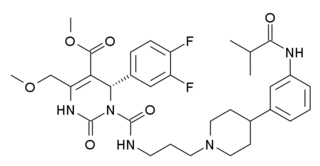
5-HT receptors, 5-hydroxytryptamine receptors, or serotonin receptors, are a group of G protein-coupled receptor and ligand-gated ion channels found in the central and peripheral nervous systems. They mediate both excitatory and inhibitory neurotransmission. The serotonin receptors are activated by the neurotransmitter serotonin, which acts as their natural ligand.
Melanocortin receptors are members of the rhodopsin family of 7-transmembrane G protein-coupled receptors.
Two Melanin-concentrating hormone receptors (MCHR) have recently been characterized: MCH-R1 and MCH-R2. These two receptors share approximately 38% homology.

Siramesine is a sigma receptor agonist, selective for the σ2 subtype. In animal studies, siramesine has been shown to produce anxiolytic and antidepressant effects. It was developed by the pharmaceutical company H Lundbeck for the treatment of anxiety, although development was discontinued after clinical trials showed a lack of efficacy in humans. Siramesine has been shown to produce an enhanced antidepressant effect when co-administered with NMDA antagonists. It has also been used to study the σ2 activity of cocaine, and has been shown to produce anticancer properties both in vitro and in vivo.

Neuropeptide Y receptor type 5 is a protein that in humans is encoded by the NPY5R gene.

Metabotropic glutamate receptor 2 (mGluR2) is a protein that, in humans, is encoded by the GRM2 gene. mGluR2 is a G protein-coupled receptor (GPCR) that couples with the Gi alpha subunit. The receptor functions as an autoreceptor for glutamate, that upon activation, inhibits the emptying of vesicular contents at the presynaptic terminal of glutamatergic neurons.

Melanin-concentrating hormone receptor 1, also known as MCH1, is one of the melanin-concentrating hormone receptors found in all mammals.

Melanin-concentrating hormone receptor 2 (MCH2) also known as G-protein coupled receptor 145 (GPR145) is a protein that in humans is encoded by the MCHR2 gene.

SB-258585 is a drug which is used in scientific research. It acts as a potent, selective and orally active 5-HT6 receptor antagonist, with a Ki of 8.9nM. It is used in its 125I radiolabelled form to map the distribution of 5-HT6 receptors in the brain.

SB-399885 is a drug which is used in scientific research. It acts as a potent, selective and orally active 5-HT6 receptor antagonist, with a Ki of 9.0nM. SB-399885 and other 5-HT6 antagonists show nootropic effects in animal studies, as well as antidepressant and anxiolytic effects which are comparable to and synergistic with drugs such as imipramine and diazepam, and have been proposed as potential novel treatments for cognitive disorders such as schizophrenia and Alzheimer's disease.

2-Methyl-6-(phenylethynyl)pyridine (MPEP) is a research drug which was one of the first compounds found to act as a selective antagonist for the metabotropic glutamate receptor subtype mGluR5. After being originally patented as a liquid crystal for LCDs, it was developed by the pharmaceutical company Novartis in the late 1990s. It was found to produce neuroprotective effects following acute brain injury in animal studies, although it was unclear whether these results were purely from mGluR5 blockade as it also acts as a weak NMDA antagonist, and as a positive allosteric modulator of another subtype mGlu4, and there is also evidence for a functional interaction between mGluR5 and NMDA receptors in the same populations of neurons. It was also shown to produce antidepressant and anxiolytic effects in animals, and to reduce the effects of morphine withdrawal, most likely due to direct interaction between mGluR5 and the μ-opioid receptor.

3-( ethynyl)pyridine (MTEP) is a research drug that was developed by Merck & Co. as a selective allosteric antagonist of the metabotropic glutamate receptor subtype mGluR5. Identified through structure-activity relationship studies on an older mGluR5 antagonist MPEP, MTEP has subsequently itself acted as a lead compound for newer and even more improved drugs.

Lu AA-33810 is a drug developed by Lundbeck, which acts as a potent and highly selective antagonist for the Neuropeptide Y receptor Y5, with a Ki of 1.5nM and around 3300x selectivity over the related Y1, Y2 and Y4 receptors. In animal studies it produced anorectic, antidepressant and anxiolytic effects, and further research is now being conducted into its possible medical application in the treatment of eating disorders.

SNAP-94847 is a drug used in scientific research, which is a selective, non-peptide antagonist at the melanin concentrating hormone receptor MCH1. In animal studies it has been shown to produce both anxiolytic and antidepressant effects, and also reduces food consumption suggesting a possible anorectic effect.
GW-803430 (GW-3430) is a drug used in scientific research and is a selective non-peptide antagonist at the melanin concentrating hormone receptor MCH1. In animal studies it has anxiolytic, antidepressant and anorectic effects.

SNAP-7941 is a drug used in scientific research, which is a selective, non-peptide antagonist at the melanin concentrating hormone receptor MCH1. In initial animal studies it had promising anxiolytic, antidepressant and anorectic effects, but subsequent trial results were disappointing, and the main significance of SNAP-7941 is as the lead compound from which more potent and selective antagonists such as SNAP-94847 were developed, although it continues to be used for research into the function of the MCH1 receptor.

NGD-4715 is a drug developed by Neurogen, which acts as a selective, non-peptide antagonist at the melanin concentrating hormone receptor MCH1. In animal models it has anxiolytic, antidepressant, and anorectic effects, and it has successfully passed Phase I clinical trials in humans.

MGS-0039 is a drug that is used in neuroscientific research, which acts as a potent and selective antagonist for group II of the metabotropic glutamate receptors (mGluR2/3). It produces antidepressant and anxiolytic effects in animal studies, and has been shown to boost release of dopamine and serotonin in specific brain areas. Research has suggested this may occur through a similar mechanism as that suggested for the similarly glutamatergic drug ketamine.

SB-243213 is a research chemical which acts as a selective inverse agonist for the 5HT2C receptor and has anxiolytic effects. It has better than 100x selectivity for 5-HT2C over all other receptor subtypes tested, and a longer duration of action compared to older 5-HT2C antagonist ligands.

PF-4455242 is a selective, short-acting (non-"inactivating") antagonist of the κ-opioid receptor. Discovered by Pfizer in 2009, it was pursued in a phase I clinical trial for the treatment of bipolar disorder, and was also investigated as a treatment for depression and substance abuse. However, development was stopped in September 2010 due to toxicology findings in animals that had been exposed to the drug for three months.

















